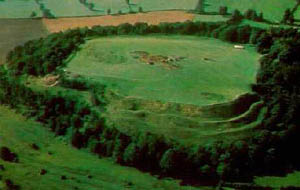
Where was Camelot?
Camelot... the fictional castle of King Arthur. Or was it for real? No one has ever been able to pinpoint the exact place of where Camelot should have been. Perhaps simply because it never existed or because the present day name of the castle or town has changed since Camelot fell due to the death of Arthur leaving no one to succeed him.
But there is one very good possibility for the old place called 'Camelot', and that's Cadbury.
 The stories of King Arthur at the hillfort of South Cadbury, near the villages of Queen and West Camel, are not very old. John Leland (or Leyland) was ordered to collect information about 'England's Antiquities' and travelled the country to collect these. In 1542 he recorded: The stories of King Arthur at the hillfort of South Cadbury, near the villages of Queen and West Camel, are not very old. John Leland (or Leyland) was ordered to collect information about 'England's Antiquities' and travelled the country to collect these. In 1542 he recorded:
Right at the South end of South Cadbury Church stands Camalatte. This was once a noted town or castle, set on a real peak of a hill, and with marvellously strong natural defences to which are two enterings up by a very steep way: one by the North and one by the South West. The root of this hill is over a mile in cumpace. In the upper part of the hill there are 4 diches or and wooden trenches to make them stronger. At the top of the hill above alle trenches there is a great area of 20 acres (est.), where in diverse places foundations of walls can still be seen. There was a lot of blue stone which the people of the village have used again and taken away.
"Roman coins of gold, silver and copper have been turned up in large quantities during ploughing there, and also in the fields at the foot of the hill, especially on the East side. Many other antiquities have also been found, including at Camelot, within memory, a silver horseshoe. The only information local people can offer is that they have heard that Arthur frequently came to Camalatte."
"Lord Hungreford was owner of this Camallat. Now Hastings the Earle of Huntendune, by his mother. Diverse villages there about bare the name of Camalat by an addition, as Quene-Camallat [Queen's Camel], and other. "All the ground by South West and West of Camalatte lay in a vale, so that on one of the two ways you are spotted from far off.
Archeology
|











